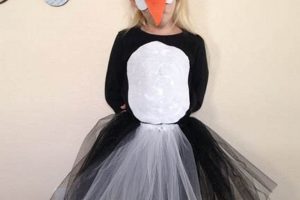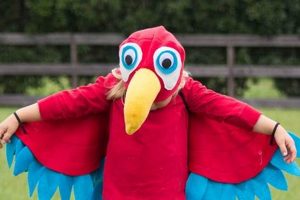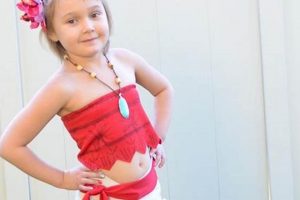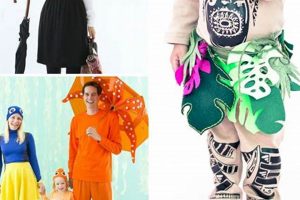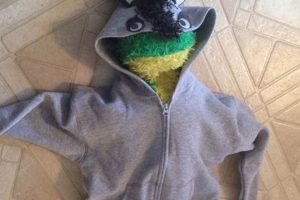The creation of a homemade Elmo outfit involves the construction of a representation of the popular children’s television character, Elmo, utilizing readily available materials and individual crafting skills. Such projects often entail sewing, gluing, and the repurposing of fabrics and accessories to resemble Elmo’s distinctive features. An example would be crafting a bright red fleece covering for a child’s head, attaching large googly eyes, and creating an orange nose from felt.
This approach to costume creation offers several advantages. It provides a cost-effective alternative to purchasing pre-made costumes, enabling families to save money. Furthermore, it fosters creativity and resourcefulness, encouraging individuals to engage in hands-on activities. Historically, making one’s own costumes has been a tradition linked to holidays, performances, and community events, allowing for unique expressions of personality and skill.
The subsequent sections will delve into specific methods, required materials, and step-by-step instructions for producing such an outfit. It will also address potential challenges and provide tips for achieving a successful and recognizable result.
Tips for Crafting a Successful Homemade Elmo Outfit
Achieving a satisfactory representation of Elmo requires careful planning and execution. The following recommendations aim to assist in the creation of a visually appealing and structurally sound outfit.
Tip 1: Material Selection. Opt for soft, plush materials such as fleece or felt for the primary body of the costume. These materials are comfortable to wear and effectively mimic Elmo’s furry texture. For instance, using anti-pill fleece will prevent the material from pilling after repeated use.
Tip 2: Accurate Color Matching. Ensure that the chosen red fabric closely matches Elmo’s signature bright red color. Inaccurate color selection can significantly detract from the costume’s authenticity. Cross-reference fabric swatches with images of Elmo under various lighting conditions to minimize discrepancies.
Tip 3: Proper Proportions. Maintain accurate proportions when constructing Elmo’s facial features. The size and placement of the eyes and nose are crucial to achieving a recognizable likeness. Use a reference image with accurate measurements to guide construction.
Tip 4: Secure Attachment. Employ robust adhesives and stitching techniques to securely attach all components, including eyes, nose, and any additional embellishments. Weak attachments can result in parts detaching during wear, compromising the costume’s integrity and potentially creating hazards.
Tip 5: Prioritize Comfort. The costume should be comfortable to wear, allowing for ease of movement and breathability. Avoid using excessively heavy materials or creating overly constricting designs. Consider incorporating ventilation openings to prevent overheating.
Tip 6: Durability Enhancement. Reinforce seams and stress points with additional stitching or fabric interfacing to enhance the costume’s durability. This will help the outfit withstand repeated wear and washing.
Tip 7: Size Consideration. Accurately measure the intended wearer to ensure a proper fit. A costume that is too large or too small will be uncomfortable and visually unappealing. Consider adding adjustable closures or elastic components to accommodate minor variations in size.
Following these recommendations will enhance the likelihood of producing a visually appealing, durable, and comfortable representation. Attention to detail and careful execution are paramount to success.
The subsequent section will provide guidance on troubleshooting common challenges encountered during construction.
1. Fabric Selection
Fabric selection is a foundational element in the successful creation of a homemade Elmo outfit. The chosen material directly impacts the costume’s visual appeal, comfort, and durability. The selection process necessitates a consideration of factors such as texture, color, weight, and cost. For instance, using a rough, scratchy fabric would detract from Elmo’s characteristic plushness and render the costume uncomfortable for the wearer. Conversely, selecting a high-quality, soft fleece or felt provides a more authentic and enjoyable experience.
The appropriate fabric directly influences the fidelity of the Elmo representation. Elmo’s iconic red color must be accurately replicated. A shade that is too dark or too light will diminish the overall likeness. Furthermore, the fabric’s texture should mimic Elmo’s furry appearance. Smoother fabrics can appear less convincing. Consider the weight of the fabric; heavier fabrics might be more durable, but they can also cause overheating. Choosing a lightweight, breathable fleece allows for greater comfort during extended periods of wear. One may select a material that’s easy to clean. This also helps preserve your diy elmo costume
In summary, judicious fabric selection is crucial for creating a visually accurate, comfortable, and durable homemade Elmo outfit. While budget considerations may influence the final choice, prioritizing quality and suitability will yield a more satisfactory and long-lasting result. The selection serves as the foundation upon which the remaining components of the project are built, impacting the success of the diy elmo costume.
2. Pattern Creation
Pattern creation serves as a foundational step in the construction of a homemade Elmo outfit. A well-designed pattern dictates the shape, size, and overall structure of the costume, directly influencing its visual accuracy and fit. Inadequate pattern design can result in a poorly proportioned or ill-fitting costume, thereby compromising the intended aesthetic. For example, a pattern that fails to account for the rounded contours of Elmo’s head will produce a costume that appears distorted and unconvincing. Similarly, improperly sized armholes or leg openings can restrict movement and render the costume uncomfortable to wear.
Effective pattern creation involves several stages, including accurate measurement of the intended wearer, careful drafting of pattern pieces, and meticulous cutting of fabric. The complexity of the pattern will depend on the desired level of detail and the skill of the creator. A simple, basic pattern might suffice for a rudimentary costume, while a more elaborate pattern will be required to achieve a high degree of realism. Consider, for instance, that a pattern must precisely accommodate the attachment of facial features such as the eyes and nose. Failure to account for these elements during the pattern-making process will necessitate alterations later, potentially affecting the costume’s structural integrity. Adjustments during the sewing process would be a pain to implement.
In summary, pattern creation is an indispensable component in the creation of a homemade Elmo outfit. A precise and well-executed pattern ensures a visually appealing, comf
ortable, and structurally sound costume. Challenges in pattern creation, such as inaccurate measurements or poorly drafted pieces, can lead to significant issues in the final product. Therefore, investing time and effort in the pattern-making process is crucial for achieving a successful outcome. The pattern is the blueprint upon which the diy elmo costume is brought to life.
3. Facial Features
The accurate representation of facial features is paramount in the construction of a credible homemade Elmo outfit. These elements serve as immediate identifiers, significantly impacting the recognizability and overall success of the costume.
- Eye Placement and Size
The position and dimensions of Elmo’s eyes are critical for conveying his characteristic expression. Eyes that are too close together, too far apart, or of an incorrect size will distort his likeness. For example, eyes positioned too low on the face may give the Elmo representation a sad or drooping appearance, while excessively large eyes can appear cartoonish and disproportionate. Precise measurements and careful alignment are therefore essential.
- Nose Shape and Proportion
Elmo’s orange nose is a defining feature. Its shape and size must closely mimic the original character to maintain visual fidelity. A nose that is too small may be easily overlooked, while a nose that is too large can appear overwhelming. The curvature and angle of the nose are also important considerations, as subtle variations can alter the overall impression of the face. Using a template or pattern can aid in creating a nose of appropriate dimensions and shape.
- Material Consistency
The materials used for the facial features should complement the overall texture and color scheme of the costume. Using materials that clash with the primary fabric can create a disjointed or artificial appearance. For example, if the body of the costume is made of soft fleece, the eyes and nose should also be constructed from similarly textured materials to maintain visual harmony. Inconsistent material choices can detract from the overall authenticity of the outfit.
- Secure Attachment Methods
The method of attaching the facial features must ensure secure and durable adhesion. Poorly attached features can detach during wear, compromising the costume’s integrity and potentially posing a safety hazard. Strong adhesives or reinforced stitching techniques are necessary to withstand the rigors of use. Regular inspection of the attachments and prompt repairs can prevent unexpected failures.
The successful integration of these elements is crucial for creating a visually compelling and readily identifiable homemade Elmo outfit. Attention to detail in the design and execution of the facial features directly contributes to the overall success of the project. The nuances in placement, size, shape, and attachment of these features are the key to creating an diy elmo costume that looks like the original.
4. Structural Integrity
Structural integrity, in the context of a homemade Elmo outfit, refers to the costume’s ability to maintain its shape, withstand wear, and endure repeated use without significant degradation or failure. This attribute is crucial for ensuring the costume’s longevity, functionality, and visual appeal. A lack of structural integrity can result in a costume that is prone to tearing, deformation, or detachment of components, ultimately diminishing its value and usability.
- Seam Strength and Reinforcement
Seam strength is paramount in preventing the separation of fabric panels. Weak seams can unravel under stress, leading to holes or tears. Reinforcing seams with additional stitching, overlocking, or the use of seam tape enhances their resistance to stress and prolongs the costume’s lifespan. Inadequate seam strength, for instance in areas around armholes or the base of the head, would be cause for concern.
- Material Durability and Resistance
The inherent durability of the chosen fabrics dictates the costume’s ability to withstand abrasion, stretching, and other forms of wear. Fabrics with a tight weave and high tensile strength are less susceptible to damage. The material used to create the face, for example, must resist stretching to retain its original form after repeated use. Fabric degradation due to low tear resistance will result in a compromised structural element.
- Attachment Security of Features
The secure attachment of features such as eyes, nose, and other embellishments is essential for preventing their detachment. Weak adhesives or inadequate stitching can result in these features becoming dislodged, detracting from the costume’s appearance and potentially creating a choking hazard for younger children. Thorough attachment with durable adhesives or secure stitching can prevent premature failure. The likelihood of detachment is mitigated with strong, sound features.
- Internal Support and Stabilization
Internal support structures, such as padding or interfacing, can enhance the costume’s shape retention and prevent sagging or distortion. Strategic placement of these supports can reinforce areas prone to stress or collapse, maintaining the costume’s intended form. These internal supports ensure the head remains upright or maintain the round shape of the main body. Without these features, it is more probable the costume will become disfigured.
In conclusion, structural integrity is a critical consideration in the design and construction of a homemade Elmo outfit. Adequate attention to seam strength, material durability, attachment security, and internal support ensures that the costume can withstand the demands of wear and maintain its visual appeal over time. Overlooking these aspects will lead to a product with compromised longevity and functionality, diminishing its overall value and enjoyment. Proper attention to structural integrity results in a safer and more durable product.
5. Wearability
Wearability, in the context of a homemade Elmo outfit, signifies the degree of comfort, ease of movement, and overall practicality experienced by the wearer. This attribute directly influences the costume’s suitability for its intended purpose. A costume lacking in wearability may be uncomfortable, restrictive, or even unsafe, thereby detracting from the wearer’s experience and limiting its utility. The design and construction process must prioritize factors contributing to a positive wearing experience. For instance, using breathable fabrics, incorporating flexible joints, and ensuring a proper fit are all essential considerations. A real-world example would be a costume constructed from non-breathable material, leading to overheating and discomfort, particularly during extended periods of wear or in warmer environments. Alternatively, a costume with overly tight sleeves could restrict arm movement, impeding the wearer’s ability to perform basic actions. The importance of this element must be considered.
The practical significance of understanding wearability extends to the design choices m
ade during costume creation. For example, the selection of lightweight, flexible materials for the main body of the outfit allows for a greater range of motion. Incorporating adjustable closures, such as Velcro straps or elastic bands, ensures a customizable fit that accommodates variations in body size and shape. Furthermore, the placement of seams and fasteners should be carefully considered to minimize chafing or irritation against the skin. The design should not impinge on the ability to function. For example, an Elmo outfit intended for a child participating in a parade must facilitate walking, waving, and potentially carrying small objects. The absence of such considerations will render the costume impractical and ultimately undermine its intended use. Wearability should be a primary concern during design and construction.
In summary, wearability is an indispensable component of a successful homemade Elmo outfit. Prioritizing comfort, ease of movement, and practicality is essential for maximizing the costume’s utility and ensuring a positive wearing experience. Challenges related to wearability, such as overheating, restricted movement, or discomfort, can significantly detract from the costume’s overall value. By addressing these challenges through careful design and material selection, the costume creator can produce an outfit that is not only visually appealing but also enjoyable and functional to wear. The value in wearability of a diy elmo costume results in a higher-quality, more functional end product.
Frequently Asked Questions
The following section addresses common inquiries regarding the construction of a homemade Elmo costume. These questions are intended to provide clarity and guidance for individuals undertaking this project.
Question 1: What is the estimated cost of materials for constructing an Elmo costume?
The cost varies depending on the materials selected. Budget-friendly options using repurposed fabrics may range from $20 to $40. High-quality materials such as premium fleece can increase the cost to $50 or more.
Question 2: What level of sewing skill is required to create a presentable Elmo costume?
A basic understanding of sewing techniques is recommended. Straight stitching, pattern following, and basic hand-sewing skills are beneficial. Complex designs may require intermediate sewing proficiency.
Question 3: How long does it typically take to complete an Elmo costume from start to finish?
The time commitment depends on the complexity of the design and the skill of the creator. A simple costume may take 5-8 hours to complete, while more elaborate designs can require 12-20 hours or more.
Question 4: What are the potential safety hazards associated with wearing a homemade Elmo costume?
Potential hazards include restricted vision, overheating, and tripping due to ill-fitting components. Ensure adequate ventilation, clear visibility, and a secure fit to minimize these risks. Small parts must be securely attached to prevent choking hazards.
Question 5: How should an Elmo costume be cleaned and maintained to prolong its lifespan?
Hand washing with mild detergent is recommended for most materials. Avoid harsh chemicals or machine drying, which can damage the fabric and embellishments. Store the costume in a dry, cool place to prevent mildew or discoloration.
Question 6: Can an Elmo costume be adapted for different age groups or body sizes?
Yes, the pattern can be scaled up or down to accommodate various sizes. Accurate measurements and careful pattern adjustments are essential for ensuring a proper fit. Consider adjustable closures to accommodate minor size variations.
In summary, creating an Elmo costume requires careful planning, basic sewing skills, and attention to safety. By addressing these common questions, individuals can approach this project with greater confidence and achieve a satisfactory result.
The following section will address common challenges encountered during the crafting process and offer potential solutions.
Conclusion
The preceding sections have provided a comprehensive overview of the “diy elmo costume,” encompassing design considerations, material selection, construction techniques, and common challenges. The creation of a successful representation necessitates meticulous planning, attention to detail, and a fundamental understanding of sewing and crafting principles. Factors such as structural integrity, wearability, and accurate replication of Elmo’s distinctive features are paramount to achieving a satisfactory outcome.
Ultimately, the endeavor of crafting a homemade Elmo costume represents a significant undertaking that yields the reward of a unique and personalized creation. The information presented herein should serve as a valuable resource for those embarking on this project. Continued diligence in research, preparation, and execution will enhance the likelihood of success. Future advancements in materials and techniques may further simplify the process, but the core principles outlined remain essential for achieving a commendable result.



